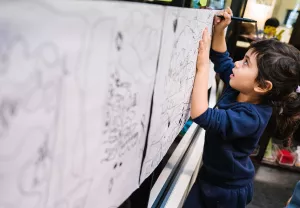New year reflections on educational programs and practice
- Home
- Latest news
- We hear you
- New year reflections on educational programs and practice

The new year is a time to renew, re-evaluate and reflect. A key aspect of an educator's role under the National Quality Framework (NQF) is promoting continuous improvement in quality education and care. In relation to educational programs and practice, consider critically reflecting on past practice to ensure an innovative and contextual 2025.
Throughout 2024 there was a wealth of information published to help shape and frame our thinking as education and care professionals. Use the prompts below to guide conversations with your team on your current educational programs and practice. Reflect on what potential changes could support positive outcomes for children and families.
AERO learning trajectories
The Australian Education Research Organisation (AERO) learning trajectories include 5 key domains that describe children's learning and development progression from birth to 5 years. AERO’s learning trajectories differ from the developmental milestones as they recognise that children learn on a continuum and that progress is not always linear. As educators, we understand that children learn best when their individual strengths and capabilities are celebrated. Watch this video and consider how you can implement the learning trajectories to capture each child's individual learning pathway.
Streamlining and reducing duplication in documentation
The topic of documentation is widely discussed across the sector. This comes with many misconceptions about the requirements approved providers and services must meet under the NQF. Did you know there is no prescribed way to meet documentation requirements? For example, the NQF does not state that you must capture daily photographs or observations of children's learning. Approaches to documentation should reflect the children, families and communities of your service. They should provide opportunities for educator and teacher learning and growth. In 2025, reflect on how you can streamline your documentation practices and reduce duplication to avoid administrative burden or educator burnout.
ACECQA documentation information sheets to support your reflections:
Educational Program Documentation for Educators and Teachers - Early childhood
Educational Program Documentation for Educators - School age care
Educational Program Documentation for Approved Providers - Early childhood
Educational Program Documentation for Approved Providers - School age care
Digital documentation and the National Model Code
Many services may choose to use digital devices to capture children's learning as part of documentation. Opportunities and challenges come with all aspects of documenting children’s learning. For example, educators can feel overwhelmed by the number of images they feel should be, or may be expected, to capture each day. This notion, alongside the release of the National Model Code, may prompt your service to review its digital documentation practices. This could include mitigating the challenges and maximising meaningful learning opportunities.
The National Model Code on taking images in early childhood education and care recommends the adoption of the following practices:
- Only service-issued devices should be used to take photos and/or videos of children.
- Personal electronic devices that can take and/or record images should not be in the possession of any person while providing education and care and working directly with children (unless for authorised essential purposes such as emergencies, health and family needs).
- Strict controls should be in place for appropriate storing and retaining of children's images and recordings.
An educator’s role also involves modelling the respectful and moderate use of digital devices within a child’s routine. Extensive use of digital devices to capture images and videos may send mixed messages to children. Learn more about digital documentation for families and explore the National Model Code.
Children's rights and voices in documentation
Respecting the dignity and rights of the child leads our practice as education and care professionals. All children have the right to feel secure, confident and included, regardless of their circumstances, strengths, gender, abilities or diverse ways of doing and being. This is outlined under Quality Area 5 of the NQS and through the United Nations Convention on the Rights of the Child. Reflect on how you ensure children's rights are maintained and empowered through your programs, practice and documentation processes.
- How do you promote children's decision-making across the service?
- How do children influence documentation processes?
- How are interactions between educators and children maintaining each child's dignity and rights?